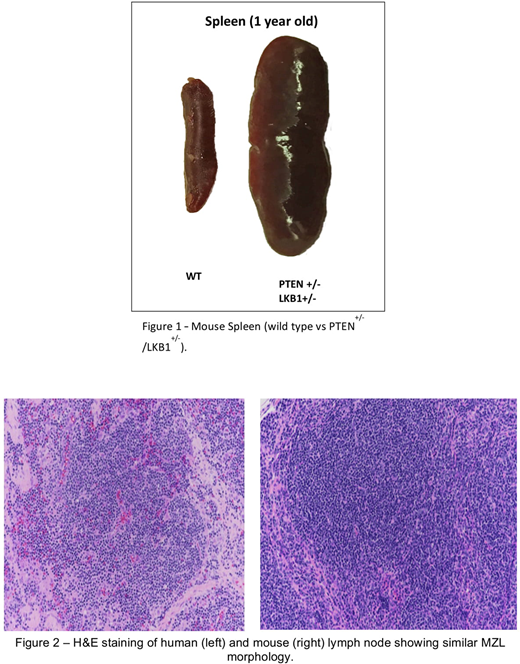Abstract
Introduction
There are roughly 75,000 new cases of Non-Hodgkin's Lymphoma every year, representing almost 5% of all new cancer diagnoses. Indolent B-Cell Non-Hodgkin's Lymphoma (i-NHL) represents a heterogeneous group of lymphoproliferative malignancies, encompassing 40% of NHL, that remains largely incurable. Follicular lymphoma and marginal zone lymphoma (MZL) are the two most common subtypes of i-NHL. The B-cell receptor signaling pathway is activated in B-cell malignancy and mediates its activity mainly through the Phosphoinositide 3-kinase (PI3K) pathway. Furthermore, novel PI3K inhibitors, such as idelalisib and copanlisib, have shown impressive clinical activity in several indolent lymphomas including MZL. This further supports the important role of the PI3K pathway in these tumors. Therefore, we hypothesized that the PI3K-mTOR (mammalian target of rapamycin) pathway is sufficient for driving the pathogenesis of marginal zone lymphomas.
Methods
In order to test our hypothesis, we generated a genetically engineered mouse model carrying heterozygous knockout alleles of both the tumor suppressor genes Phosphatase and Tensin Homolog (PTEN) and Liver Kinase B1 (LKB1), leading to over-activation of the PI3K-mTOR pathway in all mouse tissues. We closely monitored these mice for tumor formation by at least weekly physical examinations for several months. Upon tumor detection, tumor size was recorded weekly using calipers, with an experimental endpoint of 15-20mm in any dimension. Upon reaching this endpoint, or if the surrounding area became necrotic/ulcerated, if the mouse's physical/behavioral condition deteriorated, or if there were any adverse conditions warranting mouse sacrifice, the mouse was euthanized and any existing tumors and any other tissues of interest were harvested. One half of the tumor was immediately preserved in a 4% paraformaldehyde solution and prepared for sectioning, H&E and immunohistochemical staining, with CD3 (T-cell marker), and PAX-5 (B-cell marker). The 2nd half of the tumor was processed using a "stomacher" machine to dissociate the tumor cells, which were then counted and frozen in accordance with cryopreservation guidelines suggested by the American Type Culture Collection (ATCC).
Results
We generated an initial cohort of 49 Pten+/-/Lkb1+/- mice. Among all mice, the average survival time was 6 months. Thirty mice died or were sacrificed due to disease progression, defined as either lymph node enlargement and/or splenomegaly. All mice showed either lymphadenopathy or splenomegaly (Figure 1). By Kaplan-Meier analysis, we see a steady decrease in both tumor-free and overall survival after 3 months of age. Utilizing the product limit method, the median survival time was 6 months (95% CI: 6, 8). A total of 51 lymph nodes were sent for IHC and pathological identification. Of the 51 nodes, 61.5% (N=32) showed indolent Non-Hodgkin's Lymphoma, 25% (N=13) were atypical, and 11.5% (N=6) were reactive. All lymph nodes with indolent NHL were Marginal Zone subtype (Figure 2), except one case that was suspicious for follicular lymphoma. We have not identified any large cell lymphoma or development of other malignancies.
Discussion
Marginal zone lymphoma remains an incurable indolent lymphoma that lacks preclinical models. As novel agents become available, it is important to have a better understanding of the underlying pathogenesis of this malignancy and be able to model it in a immunocompetent mouse with a preserved microenvironment. Our data provides, for the first time, a proof of concept on the role of the PI3K-mTOR pathway in the pathogenesis of marginal zone lymphoma and paves the way for future studies understanding the biology of this disease, and developing rational therapies for this incurable malignancy.
No relevant conflicts of interest to declare.
Author notes
Asterisk with author names denotes non-ASH members.


This feature is available to Subscribers Only
Sign In or Create an Account Close Modal